1. Blackburn S. Placental, fetal, and transitional circulation revisited. J Perinat Neonatal Nurs. 2006; 20(4):290–294. PMID:
17310669.
2. Hermes-DeSantis E, Clyman R. Patent ductus arteriosus: pathophysiology and management. J Perinatol. 2006; 26(Suppl 1):S14–S18. PMID:
16625216.
3. Schubert U, Muller M, Norman M, Abdul-Khaliq H. Transition from fetal to neonatal life: changes in cardiac function assessed by speckle-tracking echocardiography. Early Hum Dev. 2013; 89(10):803–808. PMID:
23948155.
4. Alp H, Karaarslan S, Baysal T, Cimen D, Ors R, Oran B. Normal values of left and right ventricular function measured by M-mode, pulsed Doppler and Doppler tissue imaging in healthy term neonates during a 1-year period. Early Hum Dev. 2012; 88(11):853–859. PMID:
22805997.
5. Isaaz K. Tissue Doppler imaging for the assessment of left ventricular systolic and diastolic functions. Curr Opin Cardiol. 2002; 17(5):431–442. PMID:
12357118.
6. Negrine RJ, Chikermane A, Wright JG, Ewer AK. Assessment of myocardial function in neonates using tissue Doppler imaging. Arch Dis Child Fetal Neonatal Ed. 2012; 97(4):F304–F306. PMID:
21037287.
7. Iwashima S, Sekii K, Ishikawa T, Itou H. Serial change in myocardial tissue Doppler imaging from fetus to neonate. Early Hum Dev. 2013; 89(9):687–692. PMID:
23707048.
8. Iyer P, Evans N. Re-evaluation of the left atrial to aortic root ratio as a marker of patent ductus arteriosus. Arch Dis Child Fetal Neonatal Ed. 1994; 70(2):F112–F117. PMID:
8154903.
9. Groves AM, Kuschel CA, Knight DB, Skinner J. Echocardiographic assessment of blood flow volume in the superior vena cava and descending aorta in the newborn infant. Arch Dis Child Fetal Neonatal Ed. 2008; 93(1):F24–F28. PMID:
17626146.
10. Zhang Y, He L, Cai J, Lv T, Yi Q, Xu Y, et al. Measurements in pediatric patients with cardiomyopathies: comparison of cardiac magnetic resonance imaging and echocardiography. Cardiology. 2015; 131(4):245–250. PMID:
25969374.
11. Kluckow M, Evans N. Superior vena cava flow in newborn infants: a novel marker of systemic blood flow. Arch Dis Child Fetal Neonatal Ed. 2000; 82(3):F182–F187. PMID:
10794783.
12. Yu CM, Gorcsan J 3rd, Bleeker GB, Zhang Q, Schalij MJ, Suffoletto MS, et al. Usefulness of tissue Doppler velocity and strain dyssynchrony for predicting left ventricular reverse remodeling response after cardiac resynchronization therapy. Am J Cardiol. 2007; 100(8):1263–1270. PMID:
17920368.
13. Altın H, Karaarslan S, Karataş Z, Alp H, Şap F, Baysal T. Evaluation of cardiac functions in term small for gestational age newborns with mild growth retardation: a serial conventional and tissue Doppler imaging echocardiographic study. Early Hum Dev. 2012; 88(9):757–764. PMID:
22591553.
14. James AT, Corcoran JD, Jain A, McNamara PJ, Mertens L, Franklin O, et al. Assessment of myocardial performance in preterm infants less than 29 weeks gestation during the transitional period. Early Hum Dev. 2014; 90(12):829–835. PMID:
25463828.
15. Pees C, Glagau E, Hauser J, Michel-Behnke I. Reference values of aortic flow velocity integral in 1193 healthy infants, children, and adolescents to quickly estimate cardiac stroke volume. Pediatr Cardiol. 2013; 34(5):1194–1200. PMID:
23344893.
16. Baik N, Urlesberger B, Schwaberger B, Freidl T, Schmölzer GM, Pichler G. Cardiocirculatory monitoring during immediate fetal-to-neonatal transition: a systematic qualitative review of the literature. Neonatology. 2015; 107(2):100–107. PMID:
25412794.
17. Lee A, Liestøl K, Nestaas E, Brunvand L, Lindemann R, Fugelseth D. Superior vena cava flow: feasibility and reliability of the off-line analyses. Arch Dis Child Fetal Neonatal Ed. 2010; 95(2):F121–F125. PMID:
19996328.
18. Broadhouse KM, Price AN, Durighel G, Cox DJ, Finnemore AE, Edwards AD, et al. Assessment of PDA shunt and systemic blood flow in newborns using cardiac MRI. NMR Biomed. 2013; 26:1135–1141. PMID:
23412748.
19. Schubert U, Müller M, Norman M, Abdul-Khaliq H. Transition from fetal to neonatal life: changes in cardiac function assessed by speckle-tracking echocardiography. Early Hum Dev. 2013; 89(10):803–808. PMID:
23948155.
20. Suzue M, Mori K, Inoue M, Hayabuchi Y, Nakagawa R, Kagami S. Developmental changes in the left ventricular diastolic wall strain on M-mode echocardiography. J Echocardiogr. 2014; 12(3):98–105. PMID:
27276893.
21. Ciccone MM, Scicchitano P, Zito A, Gesualdo M, Sassara M, Calderoni G, et al. Different functional cardiac characteristics observed in term/preterm neonates by echocardiography and tissue Doppler imaging. Early Hum Dev. 2011; 87(8):555–558. PMID:
21576005.
22. Rudski LG, Lai WW, Afilalo J, Hua L, Handschumacher MD, Chandrasekaran K, et al. Guidelines for the echocardiographic assessment of the right heart in adults: a report from the American Society of Echocardiography endorsed by the European Association of Echocardiography, a registered branch of the European Society of Cardiology, and the Canadian Society of Echocardiography. J Am Soc Echocardiogr. 2010; 23(7):685–713. PMID:
20620859.
23. Harada K, Shiota T, Takahashi Y, Suzuki T, Tamura M, Takada G. Right ventricular diastolic filling in the first day of life. Tohoku J Exp Med. 1994; 172(3):227–235. PMID:
8073434.
24. Alam M, Wardell J, Andersson E, Samad BA, Nordlander R. Characteristics of mitral and tricuspid annular velocities determined by pulsed wave Doppler tissue imaging in healthy subjects. J Am Soc Echocardiogr. 1999; 12(8):618–628. PMID:
10441217.
25. Sundereswaran L, Nagueh SF, Vardan S, Middleton KJ, Zoghbi WA, Quiñones MA, et al. Estimation of left and right ventricular filling pressures after heart transplantation by tissue Doppler imaging. Am J Cardiol. 1998; 82(3):352–357. PMID:
9708666.
26. Negrine RJ, Chikermane A, Wright JG, Ewer AK. Assessment of myocardial function in neonates using tissue Doppler imaging. Arch Dis Child Fetal Neonatal Ed. 2012; 97(4):F304–F306. PMID:
21037287.
27. Tekten T, Onbasili AO, Ceyhan C, Unal S, Discigil B. Novel approach to measure myocardial performance index: pulsed-wave tissue Doppler echocardiography. Echocardiography. 2003; 20(6):503–510. PMID:
12859362.
28. Kluckow M, Evans N. Superior vena cava flow in newborn infants: a novel marker of systemic blood flow. Arch Dis Child Fetal Neonatal Ed. 2000; 82(3):F182–F187. PMID:
10794783.
29. Groves AM, Chiesa G, Durighel G, Goldring ST, Fitzpatrick JA, Uribe S, et al. Functional cardiac MRI in preterm and term newborns. Arch Dis Child Fetal Neonatal Ed. 2011; 96(2):F86–F91. PMID:
20971721.
30. Alverson DC, Eldridge MW, Johnson JD, Aldrich M, Angelus P, Berman W Jr. Noninvasive measurement of cardiac output in healthy preterm and term newborn infants. Am J Perinatol. 1984; 1(2):148–151. PMID:
6518060.
31. Hudson I, Houston A, Aitchison T, Holland B, Turner T. Reproducibility of measurements of cardiac output in newborn infants by Doppler ultrasound. Arch Dis Child. 1990; 65(1 Spec No):15–19. PMID:
2407197.
32. Hochwald O, Jabr M, Osiovich H, Miller SP, McNamara PJ, Lavoie PM. Preferential cephalic redistribution of left ventricular cardiac output during therapeutic hypothermia for perinatal hypoxic-ischemic encephalopathy. J Pediatr. 2014; 164(5):999–1004.e1. PMID:
24582011.
33. Hart J, Vemgal P, Cocks-Drew S, Harrison C, Andersen C. The relation between inferior vena cava oxygen saturation, superior vena cava flow, fractional oxygen extraction and haemoglobin affinity in sick newborns: a pilot study. Acta Paediatr. 2006; 95(1):50–55. PMID:
16373296.
34. Banait N, Suryawanshi P, Malshe N, Nagpal R, Lalwani S. Cardiac blood flow measurements in stable full term small for gestational age neonates. J Clin Diagn Res. 2013; 7(8):1651–1654. PMID:
24086865.

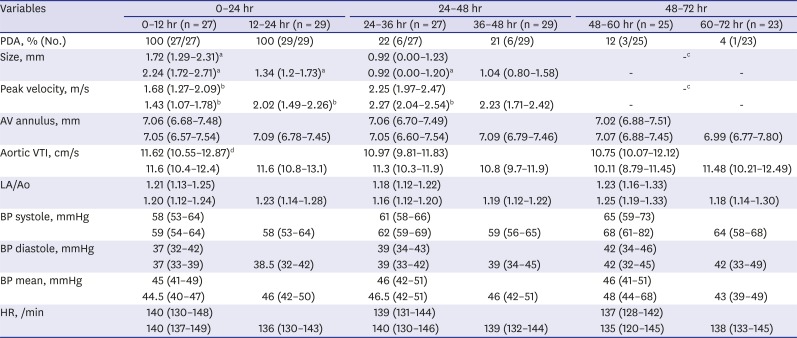
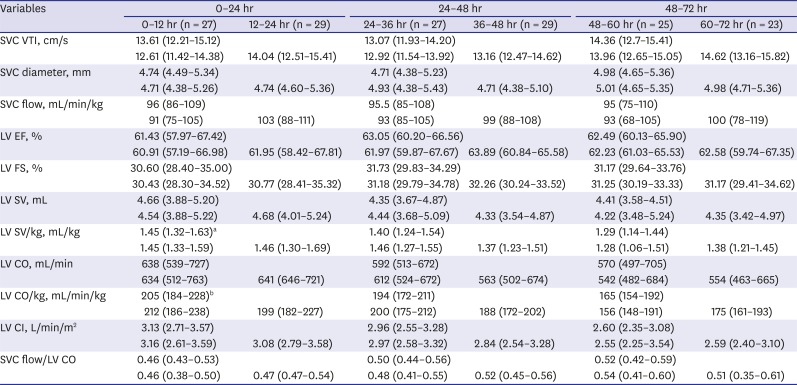
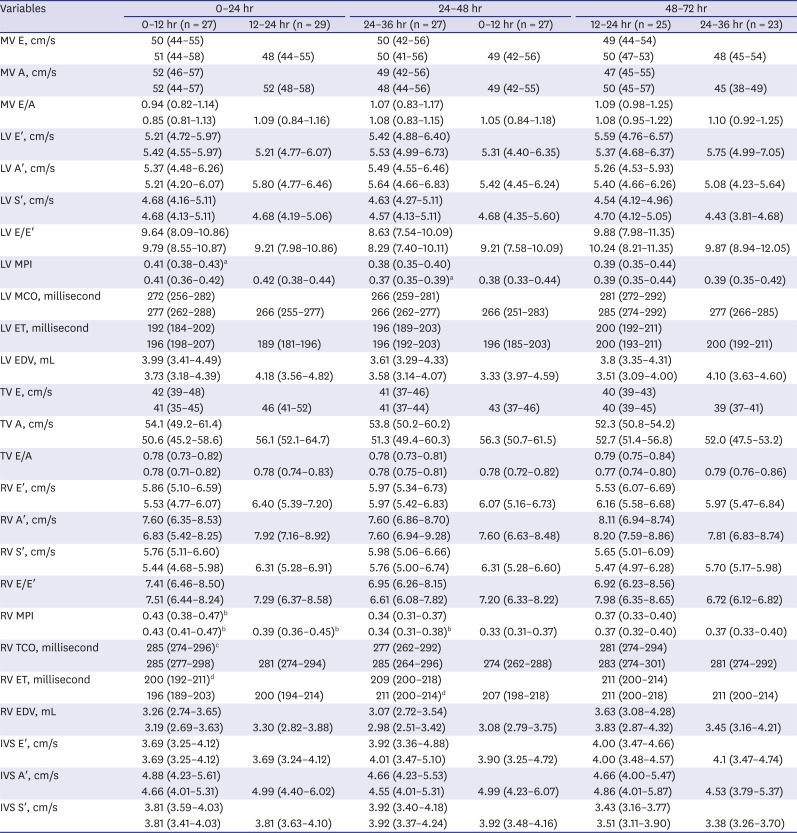
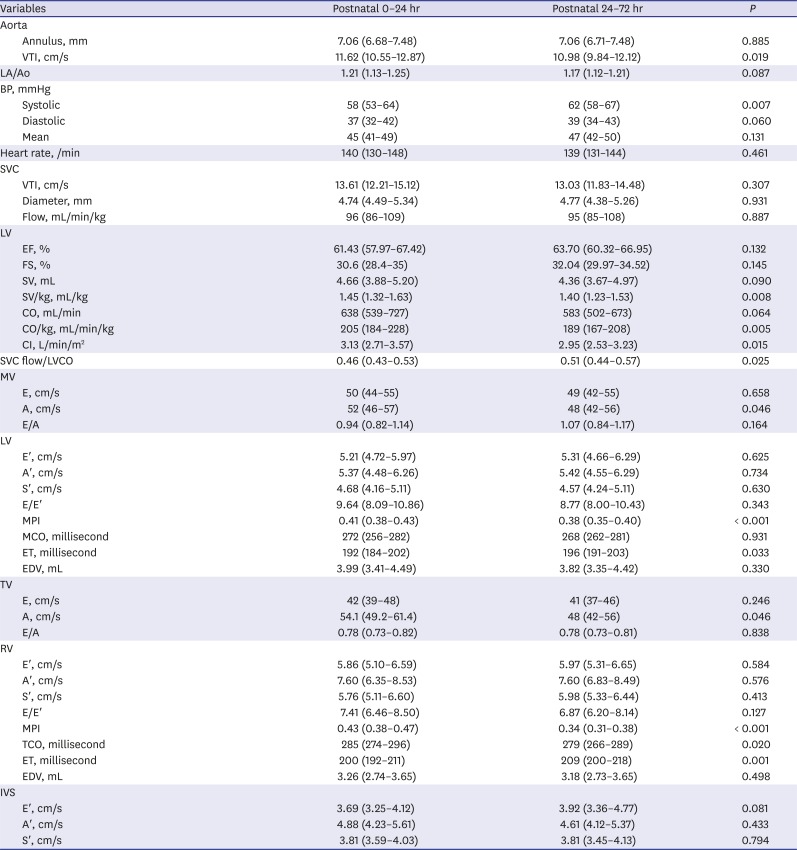
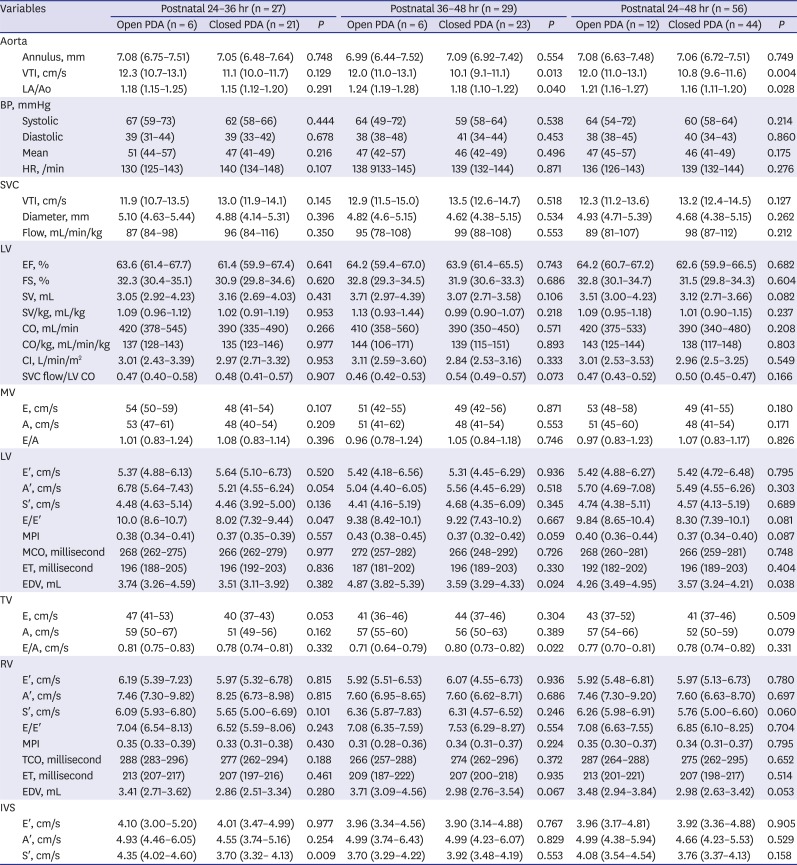




 PDF
PDF Citation
Citation Print
Print



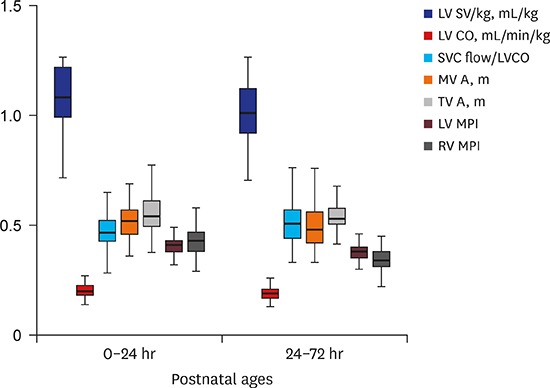



 XML Download
XML Download